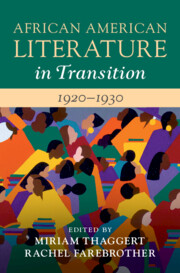Book contents
- African American Literature in Transition, 1920–1930
- African American Literature in Transition
- African American Literature in Transition, 1920–1930
- Copyright page
- Contents
- Illustrations
- Contributors
- Acknowledgments
- Chronology of Historical Events, People, and Publications, 1920–1930
- Preface
- Introduction
- Part I Habitus, Sound, Fashion
- Chapter 1 New Negro Literary Décor
- Chapter 2 The New Negro Movement’s Recording Imaginary
- Chapter 3 Sartorial Self-Fashioning in the Harlem Renaissance
- Part II Space
- Part III Uplift Renewed
- Part IV Serial Reading
- Bibliography
- Index
Chapter 2 - The New Negro Movement’s Recording Imaginary
from Part I - Habitus, Sound, Fashion
Published online by Cambridge University Press: 17 March 2022
- African American Literature in Transition, 1920–1930
- African American Literature in Transition
- African American Literature in Transition, 1920–1930
- Copyright page
- Contents
- Illustrations
- Contributors
- Acknowledgments
- Chronology of Historical Events, People, and Publications, 1920–1930
- Preface
- Introduction
- Part I Habitus, Sound, Fashion
- Chapter 1 New Negro Literary Décor
- Chapter 2 The New Negro Movement’s Recording Imaginary
- Chapter 3 Sartorial Self-Fashioning in the Harlem Renaissance
- Part II Space
- Part III Uplift Renewed
- Part IV Serial Reading
- Bibliography
- Index
Summary
This chapter traces one of the formative transitions of the Harlem Renaissance in its literary encounter with jazz and blues culture, arguing that its aesthetic was not only shaped by the music’s vital expressive forms but also its means of production, the technical recording apparatus itself. Many Harlem Renaissance writers were motivated in their artistic efforts to preserve the folk culture they felt was rapidly being lost. To do so, they paradoxically harnessed the very recording technologies they believed were hastening the demise of folk culture. Sterling Brown, Langston Hughes, Zora Neale Hurston, and others engaged with popular music and its processes of recording – its possibilities of preservation, representation, and collectivity, but also displacement and alienation – in part, as a way of understanding the craft of writing as a related technology and their own predicament as writers within commercial literary markets requiring specific kinds of raced performances.
Keywords
- Type
- Chapter
- Information
- African American Literature in Transition, 1920–1930 , pp. 46 - 72Publisher: Cambridge University PressPrint publication year: 2022

